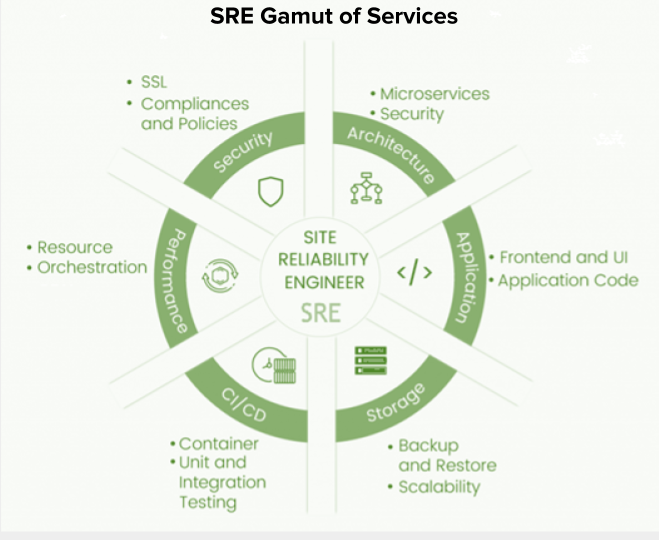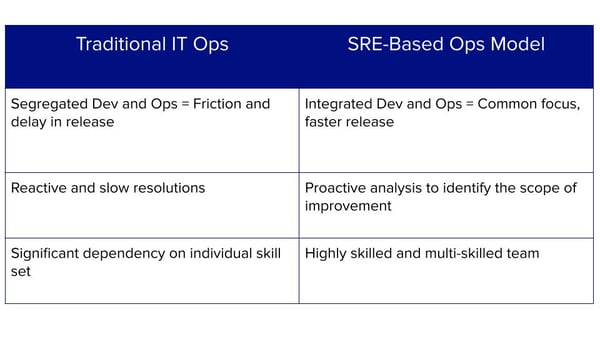To meet the customers’ expectations of speed and flexibility, businesses sought IT solutions that deliver these values while being cost-effective and reliable. Accelerated by the pandemic, several organizations are expediting the process of moving their entire IT environment to the cloud. Such choices result in trusted devices becoming preferred devices, an employee-only operation becoming an extended organization, and the need for a monolithic infrastructure to be migrated to next-generation IT tools.
These expectations gave rise to complex systems and demands to build new architectures, adopt agile application development, ensure on-demand access to infrastructure through self-service, cloud migration, and distributed computing. The result? An increase in risk of failure.
A risk of failure can make a business pay through the nose. Therefore, businesses need an integrated technology model to ensure minimal disruptions and create value. Forming an integrated technology model can be challenging, but rewarding if one right. Undertaking an effective approach involves focusing on teams, technology products, and platforms and aligning them with business goals. As businesses attempt to reduce cost while working to obtain greater operational resilience, cloud computing has evolved.
With the right infrastructure set up and strategies, businesses can dramatically expand their access to new services and products, accelerate time to market for feature release, reduce operating costs, and unleash their innovation potential. Hence, adopting SRE in the new IT Ops model becomes a fundamental necessity rather than being a choice.
Steps to Unlock Holistic Transformation on Cloud
Organizations need to undertake a holistic approach to infrastructure transformation. Only then can they capture the comprehensive cloud benefits. This change is grounded on four mutually reinforcing pillars:
-
Adopting a Site-Reliability-Engineer (SRE) Model
When operating in distributed system environments at scale your team needs to be jack of all trades. Problem-solving, networking, programming, system design, and OS internals are some of the skills required and are difficult to find in one person. The SRE approach to problem resolution emphasizes automation, improving system design to build resilience into your systems.
This empowers your teams to avoid fixing the same problems, enables them to foresee the newer failure modes, which usually may occur due to newly launched systems or features. Site reliability engineers (SREs) bundle application development and core infrastructure services in one. They work cross-functionally, partner with application developers, operations, and infrastructure teams to bring about the stability and reliability of applications in production and automate repetitive manual tasks. This increases the development team's bandwidth to focus on building products and adding application functionalities. They also support containerization and re-platforming efforts to help applications run uniformly and consistently on any cloud infrastructure.

-
Designing Infrastructure Service as Products
SREs are a part of agile product teams that are in charge of automating and completing the delivery of discrete modules that are to be used repeatedly. Additionally, these teams can offer self-service infrastructure assets with entire life cycles, like virtual servers or storage space, load balancers, which can be set up, maintained, and disassembled using automated services. For instance, a product team could publish application programming interfaces (APIs) to make it possible to build up, disassemble, and fix infrastructure assets as well as other related services and provide the open-source operating system as a service.
-
Defining objectives that inspire actions
Helps application development and infrastructure teams to achieve the streamlined, agile, automated IT infrastructure goals. However, organizations mostly either focus on tracking activities or define different objectives for different teams. Therefore, they miss out on potential values. No doubt these types of metrics are useful in assessing hybrid-ready infrastructures, but they should also be measured against business outcomes such as customer adoption.
-
Building an Engineering-Focused talent model
Your Site Reliability Engineering (SRE) team is a mix of software developers and systems engineers with a flair for building and operating reliable complex software systems at an incredible scale. SREs are technical contributors to their team, including being part of an on-call rotation. They are not in support, rather 50% of their time should be in development support. They should be able to explain to the developer what has gone wrong. How companies go about implementing this model varies on their specific situation and goals.
Aligning SRE Teams and Practices with Culture
The success of any digital integration is measured by its adoption and implementation within the organization. Therefore, organizations should start by aligning SRE teams with applications or application clusters. SREs can be introduced into the application development teams with the increasing maturity of the operating-model maturity and automation. Moreover, in teams with a homogenous technical stack, site reliability can be the full-stack developer’s responsibility instead of it being designated to a separate role.
This adoption blurs the lines between application development and infrastructure and enables the organizations to reach closer to the operating model of “hyperscalers”. SRE adoption breaks the silos making traditional infrastructure operating models compatible with agile and cloud-ready infrastructure.
Breaking the mold of Traditional IT Ops with SRE
The SRE Model achieves outcomes on account of its differences from the traditional IT Operations model:
 Adopting the SRE Model requires careful steering and not a jolt!
Adopting the SRE Model requires careful steering and not a jolt!
It is a continuous journey and requires coordination from management and all stakeholders. Therefore, when starting with SRE it is important to begin with a partner who is deft in its practices and has a proven track record. We, at Srijan, can help you mitigate this risk as an SRE partner. Being a digital experience company, SRE is a default offering in our service gamut.
We have partnered with various organizations and have owned and scaled their SRE on a defined roadmap. We begin with performing an exhaustive analysis of your existing systems, determine what comes under the purview of SRE, zero in on the how and why, and get you started on your SRE journey. Get in touch with us today.
Our Services
Customer Experience Management
- Content Management
- Marketing Automation
- Mobile Application Development
- Drupal Support and Maintanence
Enterprise Modernization, Platforms & Cloud
- Modernization Strategy
- API Management & Developer Portals
- Hybrid Cloud & Cloud Native Platforms
- Site Reliability Engineering




